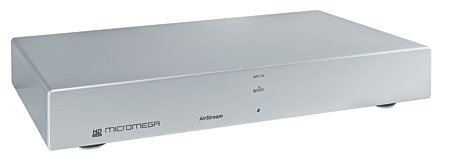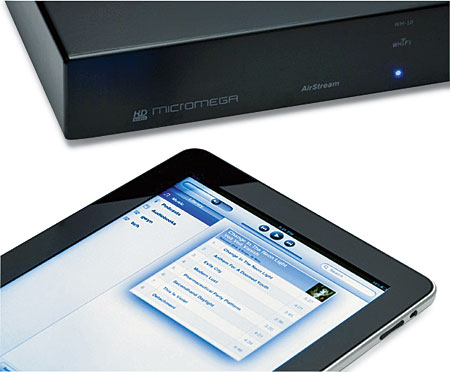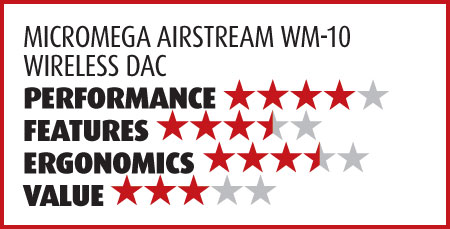Micromega AirStream WM-10 Wireless DAC Page 2

After I did this, the problem where the computer and/or the iPod touch dropped and reconnected to the wrong network was a thing of the past. There was still some latency and downright stubbornness with the Apple Remote app, though. At least now, all of the devices in the house could connect to the home network, not the AirStream. Everything worked extremely well in that regard. Of course, for $1,600, I would prefer that Micromega make the process much simpler for its customers by including the Web documentation in the user manual. It should also have a toll-free number to help users and dealers get up and running quicker. N’est-ce pas?
Now You Hear It
I import all CDs into iTunes at 320 kilobits per second, which is as high as Apple’s AAC lossy codec will go. However, Micromega was adamant that the AirStream could handle true CD quality, so I reimported duplicates of some of the music I already had on deck into iTunes, this time as full, uncompressed WAV files. When I compared two imported versions of Marc Cohn’s “Walking in Memphis,” differences between the unadulterated CD edition and the AAC codec were apparent. Some of the difference was seemingly related to volume level, but not in the way you’d normally think. All else being the same, studies show that the louder sound is the preferred sound.
So although the WAV version seemed louder, I’m convinced it was because the dynamic range and content of that recording was uncompromised. That’s something the lossy AAC version couldn’t say for itself, having been through who knows what to reduce it to roughly one-quarter size.

On Cohn’s “True Companion,” the sparse instrumentation makes it a little easier to focus on differences. In particular, the piano was more harmonically correct in the uncompressed WAV file, as you would expect. The soundstage was also a tad wider and deeper. Cohn’s gravely, wispy voice was more extended harmonically as well, as if he were that much closer to the microphone.
Symphonic music, like Mozart Piano Concertos (Ashkenazy conducting the London Philharmonic) sounded every bit as good as CD at the native data rate. It had plenty of depth, a blackness to the silence, and the pinpoint imaging I’d expect. It’s true that for much less money, I could simply install a standard iPod dock and plug in a player near my system, thus forgoing the wireless solution and getting the same music. But while it’s practical to transfer your music to huge terabyte hard drives in native lossless format, you can’t say the same for trying to store them uncompressed on your iPod. You just won’t get nearly enough in there to satisfy a music lover. Beyond that, the Micromega’s high-quality DACs, dejittering circuitry, and improved power supply should justify its purchase price in a well-balanced audiophile system—and I would say it does.
I highly recommend the AirStream at least for an audition, but obviously only if its high price is commensurate with the rest of your system. In other words, if your system has sufficient resolution to reveal incremental but still significant improvements over a standard Apple Airport, then by all means, check out the Micromega. If you think you need better speakers or a better amp, then that’s where you should put your money first.
Now You Don’t
If you’re in the habit of raking through YouTube and converting its MP3-quality sound to iTunes native MPEG-4 AAC music, you’re going to experience a lot of quiet time. None of the music I had converted from live performances I’d streamed off the Internet and recorded using one of the many freely available sound-capture applications would play through the AirStream. The odd thing is, when I tried to play one via iTunes, iTunes automatically switched over to my laptop’s internal speaker.
I’m not sure if iTunes didn’t want to transmit it or the well-bred AirStream wasn’t interested in hearing a 96-kbps transmission. Then again, if your collection is mostly freely obtained—ahem—then you probably don’t want to shell out the kind of dough it takes to own the WM-10 anyway.

Over a few hours of listening, there were occasionally one or two seconds when the sound cut out. But to be fair, it only happened a few times. Don’t expect outages to be the norm. Once the home wireless and AirStream wireless networks were bridged, the AirStream performed flawlessly. Prior to that, computers and iPod touch alike frequently switched over to the other network for no good reason.
Another consideration is your computer’s operating system. I tried with limited success to get it to work with Vista (and it did for a time). When I switched my iTunes to a Windows 7 computer, everything went much smoother. My recommendation is to ask your dealer to set up your WM-10 and iTunes computer.
Why You Need This
If your goal is to get high-quality music from iTunes to your stereo, you might think you could simply hook your computer’s headphone jack to your system and be on your way. That’s fine if you’re content with the quality of a standard PC’s built-in DACs, but you shouldn’t be. There are USB DACs available for less money (in some cases not a lot less money; in other cases a lot more). Or you could just go with the Apple Airport, which will also transmit CD-quality music. I found the Micromega to be an elegant, if not obvious, solution. It’s not simply a way to wirelessly transmit music. It’s a way to do so that results in a handoff to superior DACs, run by a superior power supply, and controlled by a remote control you’re already abundantly familiar with. Recommended for the serious only.






























































